How many times have you wished you could read minds or simply invite someone to read your mind and understand you completely?
Unfortunately, telepathy is still not a thing, and we can’t understand each other without making an active effort to communicate our feelings, thoughts, and ideas.
This is where active communication comes in.
In simple words, active communication means doing your absolute best to achieve this mutual understanding.
In this blog post, we explore the concept of active communication in the workplace, explain how it differs from passive communication and active listening, and provide real-life examples.
We also talk about the benefits of active communication and give you practical tips on how to develop your active communication skills.
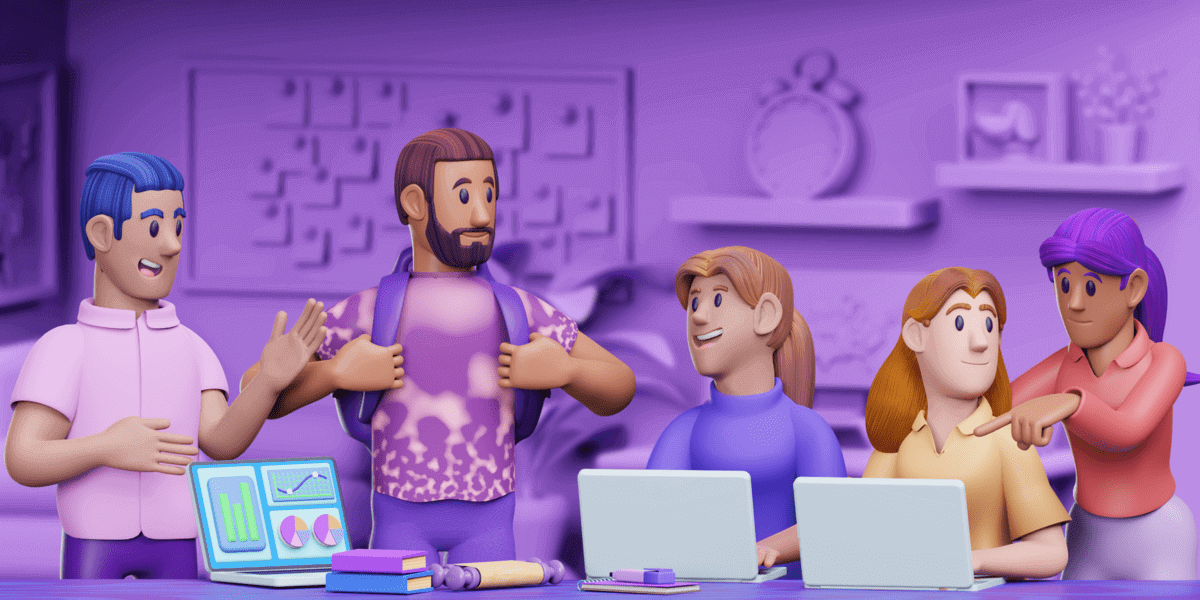
Table of Contents
What is active communication?
In simple terms, active communication is a highly involved, dynamic communication process in which the participants strive to achieve peak mutual understanding.
In this process, both (or all) sides ardently work on both understanding their interlocutor and getting their message across in the best and most effective way.
Active communicators don’t just let communication situations happen to them. They initiate these situations. And, when they find themselves part of one, active communicators are fully engaged in the process.
This means they use all their senses to explore the communication context, implications, audience, intentions, and more. They also use all the available communication tools in their arsenal to successfully relay their message.
Despite it being a rather straightforward concept, the term “active communication” is not so widely used. However, those who do use it, hint at its importance in life and work.
For example, in her paper Promoting active communication behaviours through internal communication, Alessandra Mazzei explores the role of active communication in the overall success of a company.
Some of the behaviors she considers active communication in the workplace include:
- Actively seeking, using, and sharing knowledge and information
- Seeking cross-functional communication
- Negotiating with the purpose of achieving mutual understanding
- Proactively searching for information on company values and strategies
- Informing management about potential problems
- Spreading the good word about the company externally and internally
In conclusion, active communication takes initiative, will, and intention.
What is the main difference between passive and active communication?
In an episode of The Suite Spot podcast, co-host Howard Holton, former CTO of Public Safety and Compliance for Hitachi Vantara, explores the difference between active and passive communication in terms of how our brains process information.
In his view, the only type of communication that is completely active is in-person communication.
That’s because active communication involves our brain picking up on various bits of information in real-time, such as:
- Body language
- How the other person reacts with their environment
- Microexpressions
Communication is not simply about words. It’s about putting them in context. And, when it comes to in-person communication, our mind can actively work on that, assembling a picture and successfully interpreting it.
On the other hand, all kinds of remote communication are passive to an extent, regarding how our brains act in them.
In remote communication, no matter if it’s synchronous or asynchronous, there are always some cues missing, some information we’re not getting, such as the tone of voice. Our brain tends to passively fill in those gaps with expected information, often leading to misunderstanding.
Not even video conferencing is immune to this brain response, as, in Howard’s example, for all we know, the other person may be sitting ankle-deep in water and feeling incredibly uncomfortable while we’re chatting. But, we can’t see that, so our brain just assumes everything’s fine.
Here’s a scale of the most passive to the most active communication channels, according to Howard:
Email → text → DM → telephone → video conference → in-person communication
Passive vs. active styles of communication
When we let our brains passively navigate a communication situation, we risk misunderstanding the other person and their message, as well as being misunderstood.
Consequently, the more we move away from in-person communication, the more of an active participant we need to become to ensure mutual understanding.
In other words, in-person communication usually allows for a more passive communication style, whereas remote communication necessitates an active communication style.
In remote communication, we don’t have the luxury of in-person casualness and spontaneity.
Howard explains: “If I type up an email, I’m taking an action to affirmatively communicate a point. Same with a text, same with a call. I set out with a mission to do that, even if it’s four clicks.”
In Howard’s view, in-person communication is missing that “sense of activity”.
If we want to express our approval for something a colleague did in person, we’ll simply say “Great!” without giving it much thought.
However, if we want to express the same sentiment in an email or chat, we need to be more deliberate and thoughtful.
We will consider whether to simply type out “Great” or add an exclamation point to make the message appear more enthusiastic. Should we also add a smiley face or is it too much?
We need to make an active effort to understand and be understood.
For clarification, the term “active communication” we explore in this article corresponds to Howard’s definition of an active communication style.
💡 Pumble Pro Tip
To explore a variety of communication styles you can encounter in the workplace, visit our comprehensive guide:
What is the main difference between active communication and active listening?
Active listening is the cornerstone of active communication. They are not synonymous, but we could say that active communication entails active listening.
To be a fully active participant in a conversation, you need to truly listen and understand your interlocutor.
This does not simply mean being quiet while the other person is talking. Active listening involves:
- Focus on what the other person is saying,
- Attentiveness to their nonverbal cues,
- Empathy for what they’re saying, and
- An effort to help the other person get their message across.
Without possessing the skill of active listening, you can’t be an active communicator. Even if you think you’re great at expressing your thoughts and ideas, you can’t know for sure unless you’re attuned to how the other person receives your words.
In other words, without active listening, you end up talking at people instead of to them.
What are the examples of active communication?
Here are some examples of active communication in the workplace, as showcased in the team messaging app Pumble.
🔸 Active communication example #1
HR Specialist Kate is looking for ways to make the company a better place for employees. Instead of making assumptions about what needs to be done, she actively seeks direct feedback from the employees in their business messaging app Pumble.
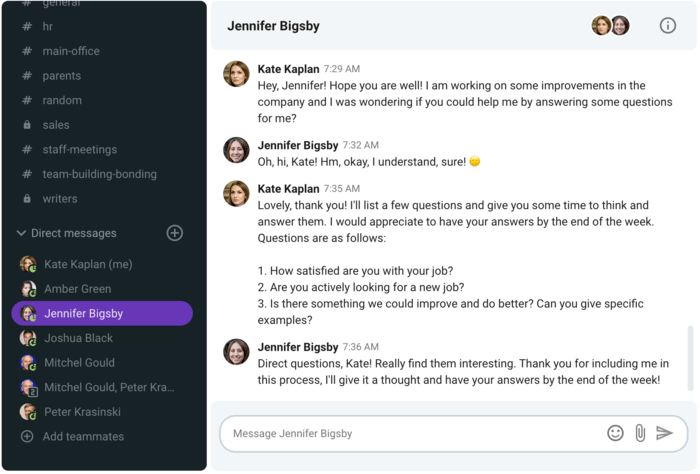
🔸 Active communication example #2
Peter is part of the team who worked on a company project that, sadly, failed. After a meeting with their project manager, he and some other team members have their doubts about the PM blaming them for the project failure.
Instead of brooding over the issue, Peter decides to take an active approach and reach out to the PM for clarification.
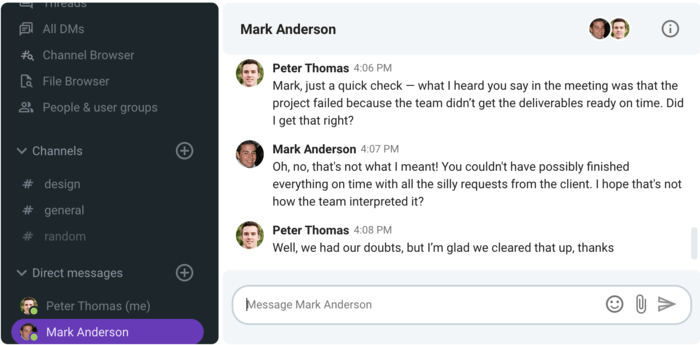
🔸 Active communication example #3
Steve is a new addition to the sales team, and it’s his first day at work. Karen decides to make Steve feel welcome by reaching out to check how his first day is going and inviting him to lunch with the rest of the team.
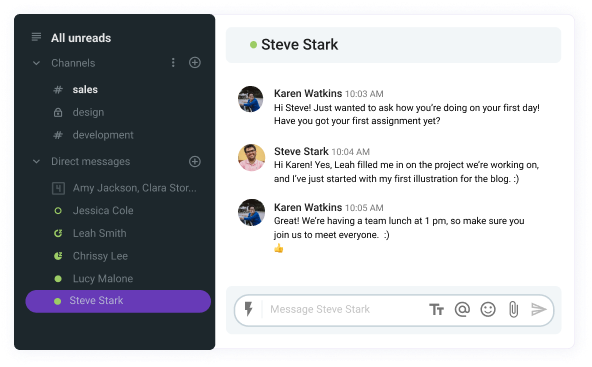
Why is active communication important in the workplace?
Some benefits of active communication that emerge from Mazzei’s paper and Holton’s podcast include the following:
- Improving cross-functional collaboration — Most projects tend to require cross-functional collaboration between members of different departments. Active communication facilitates this type of collaboration by encouraging participants to proactively reach out.
- Generating valuable resources — When employees and managers are active communicators, they are much more effective at sharing information and generating two intangible resources Mazzei sees as vital for any organization, i.e. knowledge and allegiance.
- Brand building — Active communication often spills beyond internal communication, i.e. happy employees will spread the gospel outside of the organization, thus helping to improve the company brand image.
- Strengthening remote teams — As Holton explained, remote communication requires more active participation. Therefore, active communication helps connect remote teams, strengthen their bonds, build trust, and ease collaboration.
7 Tips on how to develop your active communication skills
Active communication is seldom mentioned in academic literature.
However, a book titled Active Communication by Matthew Westra emerged in the nineties as a practical tool to help anyone in communication-oriented professions become active communicators.
The book was based on communication theories, but it was written in colloquial language and style so that anyone can use it and find it handy. It’s still fresh and relevant today.
In the book, Matthew uses an image of a pyramid to present the hierarchy of skills needed to become an active communicator.
Each level builds on the previous one and ultimately leads to active communication mastery.
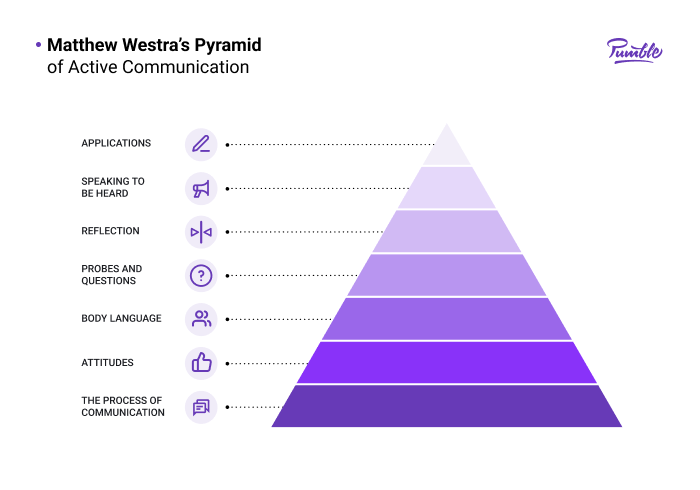
Here, we’ll discuss each skill level of the pyramid to help you understand how best to master active communication.
1️⃣ Understand the process of communication
Westra argues that to be able to improve your communication efforts, you first need to understand the basics of the communication process.
Communication typically involves the following components:
- Sender — the one who wants to communicate a message
- Receiver — the intended recipient of the message
- Message — the content the sender wants to convey
- Medium — how the message is conveyed, i.e. in written or spoken form
- Feedback — any reaction to the message
- Interference — anything that could disrupt the message and cause misunderstanding
Understanding the foundations of communication is a necessary prerequisite for building your communication skills.
💡 Pumble Pro Tip
If you want to learn more about work communication fundamentals, explore our extensive communication library:
2️⃣ Develop the right attitudes for active communication
As Westra put it: “As a filter on a camera changes the image that reaches the film, our attitudes can change the image that gets through to our mind.”
We need to approach a communication situation with the right set of attitudes that make us open to understanding and seeking clarification.
These attitudes include:
- Empathy — the ability to tune into the feelings of others (as well as yourself),
- Authenticity — allowing yourself to be who you are in communication,
- Postponing interpretations — refraining from acting on assumptions before you check them,
- Refraining from judgment — allowing the other person to communicate in an environment of acceptance instead of succumbing to the judgments you make based on your internalized values and stereotypes,
- Staying with the speaker — hearing the speaker now, instead of anticipating what they’re about to say or dwelling on what they’ve said, and
- Patience — allowing things to happen at their own pace instead of forcing them to progress or stop.
Internalizing these attitudes puts us in the right frame of mind to actively communicate, understand, and be understood.
3️⃣ Work on your body language
A lot of the communication process is nonverbal and rests on your body language.
Working on “the skills of the body”, as Westra calls them, can help you appear more open and invite trust and ease in the interlocutor.
The most important body language elements to mind in active communication include:
- Posture — having an open posture, indicating presence of mind and attentiveness,
- Eye contact — maintaining eye contact to indicate your presence,
- Voice — awareness of your vocal style and inflection and how it affects the other person,
- Hands — avoiding fidgeting with your hands as it can be distracting, and
- Your physical needs — Westra puts an emphasis on meeting your bodily needs before engaging in communication. Unmet needs, such as hunger or a full bladder, will make you distracted and frustrated, making it impossible to stay present and active.
💡 Pumble Pro Tip
Not all cultures use the same body language cues. If you work in a multicultural environment, check out our guide on cross-cultural communication:
4️⃣ Learn how to use probes and questions
Probes and questions are a powerful tool for advancing the conversation, getting it unstuck, and overcoming any hurdles in communication.
The right use of questions and probes allows you to help the other person express themselves, get clarification and vital information, and move forward.
Westra proposes three methods in this area:
- Subtle prompt — a gentle nudge letting the other person know you’re interested and they can proceed. For example, nodding or saying something as simple as “I’m listening” or “Uh-huh” can propel the conversation.
- Clarification — asking for more specific information to avoid misunderstandings. For example, you can say: “When you said ____, did you mean ____?”
- Questions — mindfully asking for more information, taking care that the question is appropriate and you understand the purpose behind it.
However, be careful when using probes and questions as they may be counterproductive.
“Why” questions can imply blame and make the other person defensive, so it’s best to avoid them altogether.
For example, if a colleague confides in you that they’ve done something wrong and they’re worried, and you ask them why they did it, they might feel attacked and judged.
💡 Pumble Pro Tip
Asking questions is a subtle affair that requires a lot of pre-thought and consideration for the other person and the context. If you want to go more in-depth with the topic of asking questions, check out our blog posts on the subject:
5️⃣ Develop skills of reflection
Active communication also entails successfully reflecting on what has been said so far in order to advance the conversation.
Westra recognizes four skills of reflection:
- Reflection of feelings — reflecting on what the other person might be feeling. It can help you check your assumptions, help them identify their unclear feelings, and help you deepen trust and understanding.
- Paraphrase — rephrasing, in simple terms, what the interlocutor appears to have said. It helps you gain clarity and gives them the chance to correct any misinterpretations.
- Summarization — a review of the main bits of information and points made during the discussion. It helps both parties see if they have understood each other and found common ground.
- Verbal tracking — making sure the other person stays on topic. This is especially useful for people who tend to veer off the tracks and lose the view of the point in the process.
However, without all the previously mentioned skills, you risk sounding patronizing and misinterpreting the other person, so tread lightly.
6️⃣ Learn how to speak to be heard
Active communicators also understand the best way to present their thoughts and ideas so that they’re heard.
In short, speaking to be understood involves being specific, direct, and concrete. In other words — no beating around the bush, say what you have to say.
However, there are some considerations you need to take into account before speaking.
➡️ Employ the right methods
Here are some methods to help you get your intended message across:
- Making “I” statements — They make it clear you’re expressing your views and not attacking theirs. For example, it’s better to say “I disagree” than “You’re wrong.”
- Exercising appropriate self-disclosure — Telling anecdotes from your life relevant to the discussion can help ease the conversation and invite trust.
- Avoiding giving advice — Giving advice when it’s not sought can sound moralizing and patronizing, and prevent open discussion.
➡️ Be mindful of the listener
We’re all different, and no matter how skilled a speaker you are, you need to consider the uniqueness of your listener before you start speaking.
Focus on the following points:
- Listener’s communication skills — Your listener may not be as skilled as you are, so you need to be aware of the fact that you may be misunderstood.
- Listener’s language — Your listener may not be familiar with the jargon you tend to use, technical terms you rely on, or similar. You may need to adjust your speech accordingly.
- Seek clarification — Just as you can check your understanding by asking for clarification, so can you ask the listener to summarize your points to check their understanding.
- Cultural considerations — You and your listener may be coming from a different cultural background, so have that in mind as well.
➡️ Think of the conversation in the context of your relationship with the listener
Your relationship dynamic also plays a vital role in the conversation.
You need to be mindful of your history, power differences, or any tensions that may play a role in successfully relaying your message.
7️⃣ Apply your skills
The final step in the pyramid is applying your newly acquired skills to all walks of life and work.
Of course, the process of acquiring these skills is not linear. You can work on them little by little, paying particular attention to one or two in a specific situation.
By applying your active communication skills in the workplace, you help create a positive work environment, where openness and transparency are valued.
Westra urges active communicators to also lead by example and find whatever opportunities they can to teach others how to better communicate themselves.
Pumble enhances active communication
Active communication means both being highly involved in any communication situation and initiating these situations yourself.
Hence, having the right communication tool, such as Pumble, at your disposal, is crucial.
First, you can always reach out to your colleagues, thanks to direct messages.
If you need to address a larger audience, you can use channels. Thanks to threads, your communication channels will remain structured and unburdened.
Although active communication is dynamic by nature, you might need to check some old messages or files from time to time. Luckily, this won’t be an issue thanks to Pumble’s unlimited message history which lets you access any message or file ever exchanged in your workspace.
Finally, if you prefer to actively communicate via calls, Pumble provides audio and video call features.




